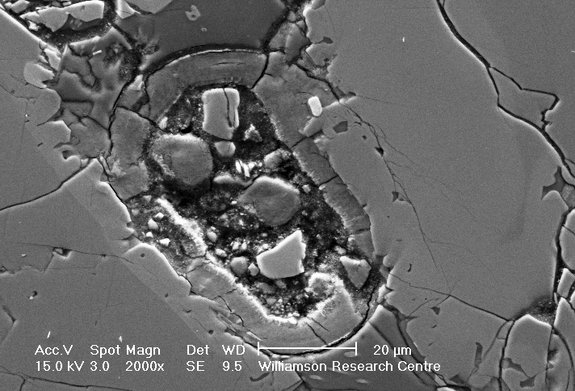I have scant doubt that life is transmitted throughout the universe in some form or the other. thus Mars would also have been inoculated. After saying that, survival on the surface is unlikely as there is ample radiative energy about to tear it apart and oxidize it.
What was possible was early wet zones been inoculated and life penetrating deep into the rock along with most of the water.
That means of course that we will never be sure until we create our own deep habitats as well and can access deep wet rocks.
..
Scientists shocked to find cell-like structures within Martian meteorite
By Andrew Fazekas
https://ca.news.yahoo.com/blogs/geekquinox/scientists-shocked-to-find-cell-like-structures-within-205639945.html
Scientists have cracked open an ancient meteorite from
Mars and say they have found strong evidence that suggests Mars may have
had life in its distant past.
The rock that crashed onto Earth over a century ago, known as the Nakhla meteorite,
has been identified by previous studies as having come from the Red
Planet and has been dated at 1.3 billion years old. The research team
discovered that deeply embedded within the rock are what looks like
egg-shaped, ’cell-like’ structures that are believed to have once held
water.While the authors of the study, published this week in the journal of Astrobiology, are not necessarily suggesting this is indeed direct evidence of Martian life itself, it may very well point to the barren planet having a habitable environment in its ancient history. And it looks like asteroid impacts could have actually helped created suitable conditions for microbes to survive – at least temporarily.
“Our research found that it probably wasn’t a cell but that it did once hold water, water that had been heated, probably as a result of an asteroid impact,” Lyon added.
This theory suggests that high-velocity impacts allowed the mixing and heating of surface permafrost with underground material on ancient Mars.
This intriguing discovery will only add to the mystery that surrounds our neighbouring world and the continued hunt for past or present life on it.
Humans continue to invade Mars, lobbing probes towards the fourth planet front the Sun in the hopes of finding answers either way.
Even India is getting in on the space exploration action, as their spacecraft is slated to arrive in orbit around Mars on Sept. 24. After a 10-month journey and having travelled nearly 700 million kilometres, The South Asian nation’s first mission to the planet, Mangalyaan, will attempt to detect methane in its atmosphere. Methane is a natural biosignature of life on Earth and could be so for Mars, too.
NASA’s latest mission to Mars, the MAVEN orbiter is also scheduled to arrive at its destination three days earlier. Its goal is to be the first spacecraft to be dedicated to exploring the upper tenuous atmosphere of Mars in the hopes of better understanding its climate cycles.
Meanwhile the American space agency also announced this past week that two years after its arrival, their one-ton Curiosity rover is finally nearing its main destination, a mountain at the centre of the giant crater Gale. Already the robotic geochemist has beamed back tantalizing evidence that its landing site was once an ancient lake filled with chemicals that could have been the building blocks for life.
Life on Mars has been hotly debated for generations, since astronomers erroneously saw what looked like canals criss-crossing its surface in the late 1800s. And the controversy heated up again nearly 20 years ago when NASA, with much fanfare, declared finding microbe fossils in another Martian meteorite.
That’s right, back in August 1996, a team of NASA scientists held a widely-covered press conference presenting what they said at the time was clear evidence of a Martian rock being altered by microbial life. Since then, however, those claims have been dismissed, with scientists explaining them away through chemical and geological processes.
Not surprisingly, this study is quite a bit more muted. However it’s expected that it will help re-ignite the hope for one day finding full proof of past or present life.
“We have been able to show the setting is there to provide life. It’s not too cold, it’s not too harsh. Life as we know it, in the form of bacteria, for example, could be there, although we haven’t found it yet,” Lyon said.
“It’s about piecing together the case for life on Mars – it may have existed and in some form could exist still.”

No comments:
Post a Comment